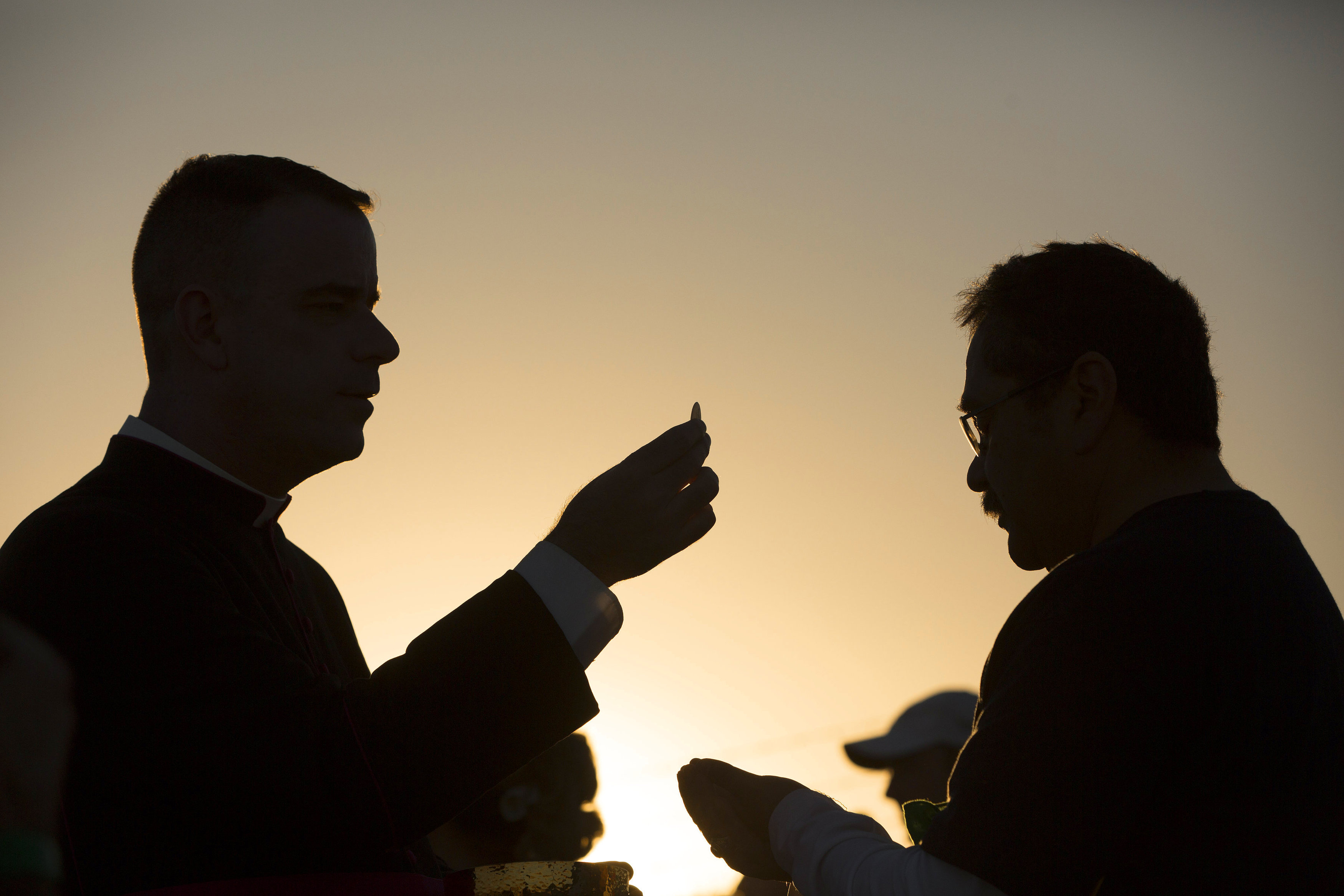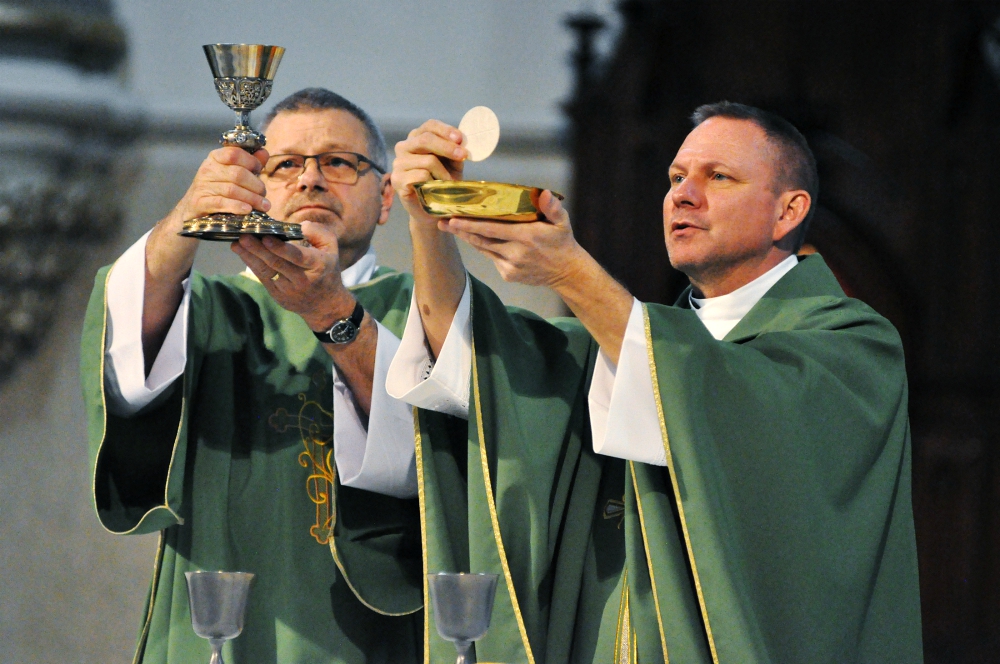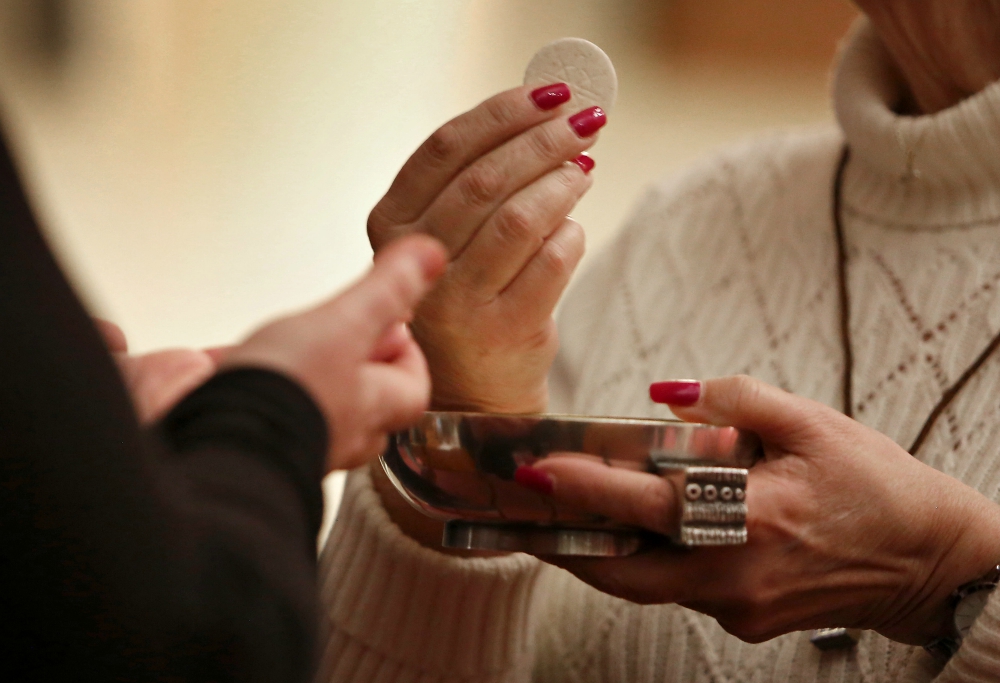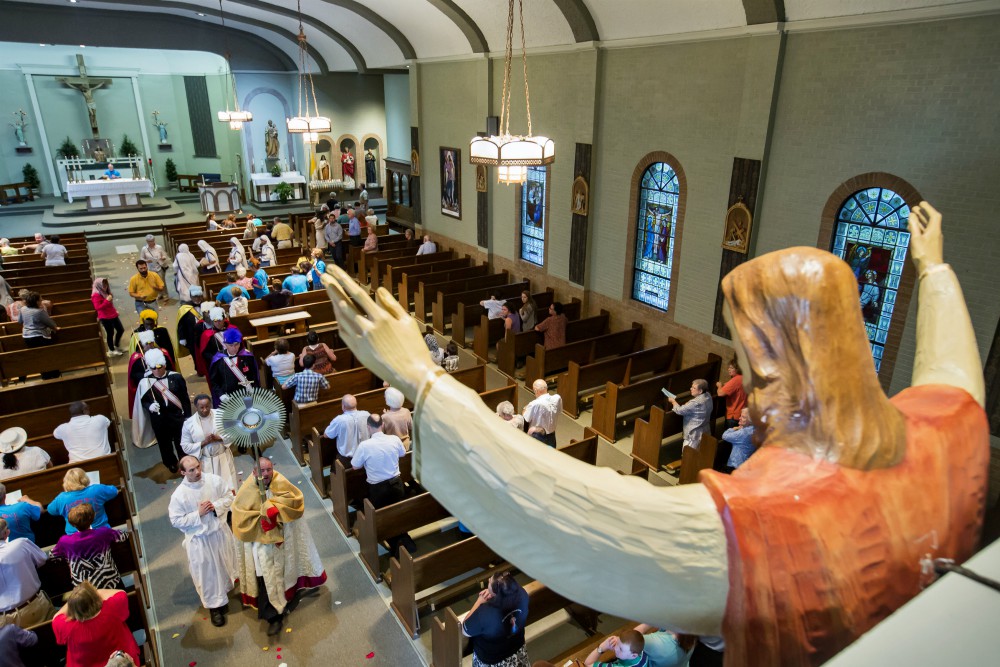
A man receives Communion on the U.S. side of the border in El Paso, Texas, Feb. 17, 2016, as Pope Francis celebrated Mass in Ciudad Juárez, Mexico. (CNS/Nancy Wiechec)
A poll that purported to show that a majority of U.S. Catholics do not believe church teaching about the real presence of Jesus in the Eucharist had commentators blaming Communion in the hand, lay eucharistic ministers, and even the Second Vatican Council. Catholic writer Flannery O'Connor, who once wrote, "Well, if it's a symbol, to hell with it," was quoted more than a few times.
But sacramental theologians, liturgists and pollsters say the wording of the poll question likely skewed the data, since the results vary significantly from differently phrased surveys on the same topic from the past decade.
Experts agreed the church could do more to educate adult Catholics on this important, but complex, teaching, but also suggested that while not all Catholics may understand the history and nuances of teaching on the Real Presence and transubstantiation, many of them "get it" on a more general level.
"It's very difficult to determine from this survey how much of the disappointing results are a function of the phrasing of the question and how much is a function of what people really do or do not understand about transubstantiation and Real Presence," said Timothy Brunk, associate professor of theology at Villanova University in Pennsylvania.
Released last week by the Pew Research Center, the results of two polling questions claimed, "Just one-third of U.S. Catholics agree with their church that Eucharist is body, blood of Christ." The questions were part of a broader study of Americans' knowledge about religion, which found pervasive ignorance. (Overall, the average U.S. adult only answered fewer than half of 32 fact-based, multiple-choice questions about topics related to religion correctly.)
Pew's transubstantiation questions asked both what the church teaches and what self-described Catholics believed, giving three multiple-choice options to describe what happens to the bread and wine used for Communion.
- Actually become the body and blood of Jesus Christ
- Are symbols of the body and blood of Jesus Christ
- Not sure
In describing their own beliefs, 69% overall chose "symbols," while 31% chose "actually become the body and blood of Jesus Christ." Regular Massgoers were more likely to choose "actually become" (63%), as were older Catholics, though majorities in every age group picked "symbols."
Those stats — which would indicate significant decline in just the last decade — had commentators railing against what they saw as alarming lack of assent to a critical Catholic belief.

Deacon David Bartolowits, left, and Fr. Rick Nagel elevate the Eucharist during a Feb. 7 Mass at St. John the Evangelist Church in Indianapolis. (CNS/The Criterion/Sean Gallagher)
"It represents a massive failure on the part of Catholic educators and catechists, evangelists and teachers," Los Angeles Auxiliary Bishop Robert Barron said in a video response, echoing his persistent theme that apologetics is the key to reversing decline in religious affiliation among young people.
Writing in the conservative Catholic Herald, Fr. Dwight Longenecker opined that the results proved that "the great divide today is no longer between Protestant and Catholic, but between those who believe in a revealed religion and those who believe it is all a symbol."
Similarly, Barron used the phrase "only a nice symbol" to describe the choice of the majority of respondents. That, however, was not the wording in the Pew survey, which said simply "symbols."
In fact, Barron's wording more closely resembles the phrasing used by three sociologists of religion in a 2011 study: "The bread and wine are only symbols of the body and blood of Jesus Christ" (emphasis NCR's). Phrased that way, only 37% chose "only symbol" — almost half as many in the Pew study.
That discrepancy caught the attention of Mark Gray, senior research associate for the Center for Applied Research in the Apostolate (CARA). He called the Pew question "poorly phrased" for failing to capture the "nuance and complexity" of church teaching — admittedly difficult to do in a brief survey question.
Gray also noted that a 2008 study found similar results to the 2011 one, with 74% of Catholics (and even a majority of other Christians) expressing belief in Real Presence when asked the yes-or-no question: "Do you believe that when people take Holy Communion, the bread and wine become the body and blood of Jesus Christ, or do you believe that does not happen?"

A eucharistic minister distributes Communion Jan. 3 at St. Mother Theodore Guerin Parish in Elmwood Park, Illinois. (CNS/Chicago Catholic/Karen Callaway)
He also speculated that the adverb "actually" in the Pew response option ("actually becomes ...") may have confused respondents and suggested that using "really" (as the 2008 study did) might produce a different result.
An even clearer wording, he suggested in a blog post, would be: "Jesus Christ is really present in the bread and wine of the Eucharist" vs. "Bread and wine are symbols of Jesus, but Jesus is not really present." CARA will test that hypothesis in the fall with further polling that uses various wording, he said.
Words matter
Complicating matters are the history of what words like "symbol" and "real" have meant and what they imply today, say theologians. "We don't really have the greatest clarity, at least in U.S. culture, about what these words mean or how we're using them," said Stephen Okey, assistant professor of philosophy, theology and religion at St. Leo University in Florida, who tweeted about the survey.
Brunk said the Pew study's wording assumes that "real" and "symbol" are dichotomous categories when they are not. "If the Pew survey person called me and asked, 'Do you think the Eucharist is real or a symbol?' I would say, 'Yes,' " he said.
The church does teach that Eucharist is a sign or symbol. All the sacraments are "outward sign[s] instituted by Christ to give grace," as those who memorized the Baltimore Catechism may recall.
Although today's common use of the word "symbol" implies something "less real," Catholic theology has distinguished between such "figurative" symbols (that only refer to something) and those that are actually bring about or create what they represent — what theologian Karl Rahner called "actualizing" or "real symbols."
Theologians often use the example of a kiss, which is not only a symbol of love but something that enacts or deepens love. "Likewise, but on a grander scale, the sacramental celebrations of the church express and deepen what it means to be church," Brunk said.
Advertisement
Subtle differences in wording aside, most Catholics likely "take Jesus at his word" when he said the bread and wine were his body and blood at the Last Supper, said Xavier Montecel, a doctoral fellow studying sacramental theology and Christian ethics at Boston College.
This is what is meant by the teaching on the Real Presence — not to be confused with transubstantiation, which is an explanation about how the bread and wine become Jesus' body and blood.
"They're not equivalent," said Anne McGowan, assistant professor at Catholic Theological Union in Chicago. "You don't need transubstantiation to have belief in the Real Presence."
For example, Eastern Christians believe in the Real Presence but do not have the doctrine of transubstantiation to explain it, she noted.
In the Western church, the doctrine of transubstantiation comes much later. In 1215, the Fourth Lateran Council used the word "transubstantiated," but it wasn't until the 13th century that St. Thomas Aquinas elaborated on the teaching, adopting Aristotelian metaphysical concepts of "substance" and "accident" to explain the change.
Aquinas explained that the "substance" of the Eucharist — the essence of its deepest reality — changed from bread and wine to body and blood, but not the "accident' — or external physical properties. Thus, consecrated hosts and wine still look like bread and wine, even under a microscope, and partakers of the Eucharist are not cannibals.
The Council of Trent — responding to the Protestant Reformation — confirmed that teaching, which is now contained in the Catechism of the Catholic Church, which says that in the Eucharist, "the body and blood, together with the soul and divinity, of our Lord Jesus Christ and, therefore, the whole Christ is truly, really, and substantially contained."

Fr. Michael Champagne carries the Blessed Sacrament at St. John Francis Regis in Arnauldville, Louisiana, Aug. 15, 2016, on the feast of the Assumption. (CNS photo/Tim Mueller)
That word "really" refers to a metaphysical realness, not a physical reality, although today's post-Enlightenment mindset, which preferences that which can be observed or studied, may mistakenly lead some to believe that transubstantiation means Christ is physically present in the Eucharist, Montecel said.
The word "actually" — as used in the Pew study — may be even more likely to have been interpreted as referring to a physical change and may explain why few Catholics chose that response, Montecel said. If so, they were correct, in that the church does not teach that there is a physical change.
In other words, communicants are not "eating Jesus' thigh," as one theologian put it.
Catechesis needed
Children preparing for first Communion may not have the abstract thinking to understand transubstantiation (and "a full and perfect knowledge of Christian doctrine is not necessary," according to an encyclical from Pope Pius X).
But children — and presumably adults — are obliged, according to their ability, to continue to learn church teaching, challenging preachers, teachers and others in ministry to further explain these concepts and help Catholics make them applicable to their lives.
Brunk agrees with Barron on the need for improved catechesis but isn't sure that transubstantiation should be the lynchpin. "Religion is not just Sunday morning," Brunk said, noting that "God's offer of grace is constant."

Children at St. Augustine Catholic Church in Memphis, Tennessee, pray during their first Communion May 19. (CNS/Karen Focht)
If Catholics leave Mass "charged with charity, compassion and justice," he said, then "they're getting it, even if they are not drawing the distinctions of Aristotelian substance and accident."
That some Catholics mistakenly believe in a physical change during transubstantiation may indicate the necessity of more in-depth and nuanced explanations of the teaching, said Montecel. "There is a need for the kind of teaching that meets people where they are and treats them like grownups in their faith," he said.
The topic is popular among those going through RCIA, who often want to understand how the Catholic Church's teaching differs from other Christian denominations, said Okey, who entered the church through RCIA and has led groups in his parish.
"I don't know how much someone needs to understand the nitty-gritty of sacramental theology to be a spiritual and prayerful Catholic," he said, but he believes better catechesis could lead to a "more faithful posture toward the Eucharist," especially since the church teaches that Eucharist is the central way in which Catholics encounter Christ.
While Vatican II called Eucharist the "source and summit" (or "font and apex") of the Christian life (Lumen Gentium), it also affirmed Christ's presence in other parts of the liturgy: in the Word proclaimed and preached, in the presider and in the assembly (Sacrosanctum Concilium).
"Ultimately you're explaining a mystery," said McGowan, who suggests "appropriate humility" in trying to understand "how Christ becomes present not only in the Eucharist but in other areas of our lives."
As important as understanding transubstantiation is, Catholics should remember that Eucharist is in service of a larger change in the people, said McGowan. "We are supposed to become the body and blood of Christ, broken and poured out for the life of the world," she said. "That's the real change that ultimately matters."
[Heidi Schlumpf is NCR national correspondent. Her email address is hschlumpf@ncronline.org. Follow her on Twitter @HeidiSchlumpf.]





